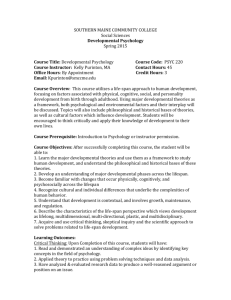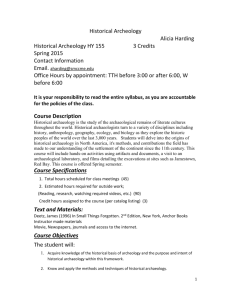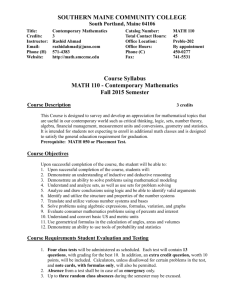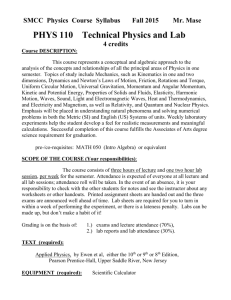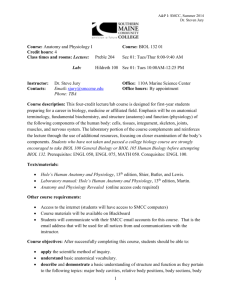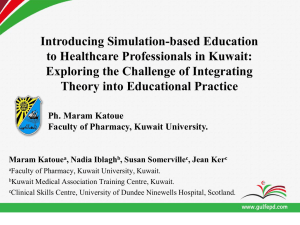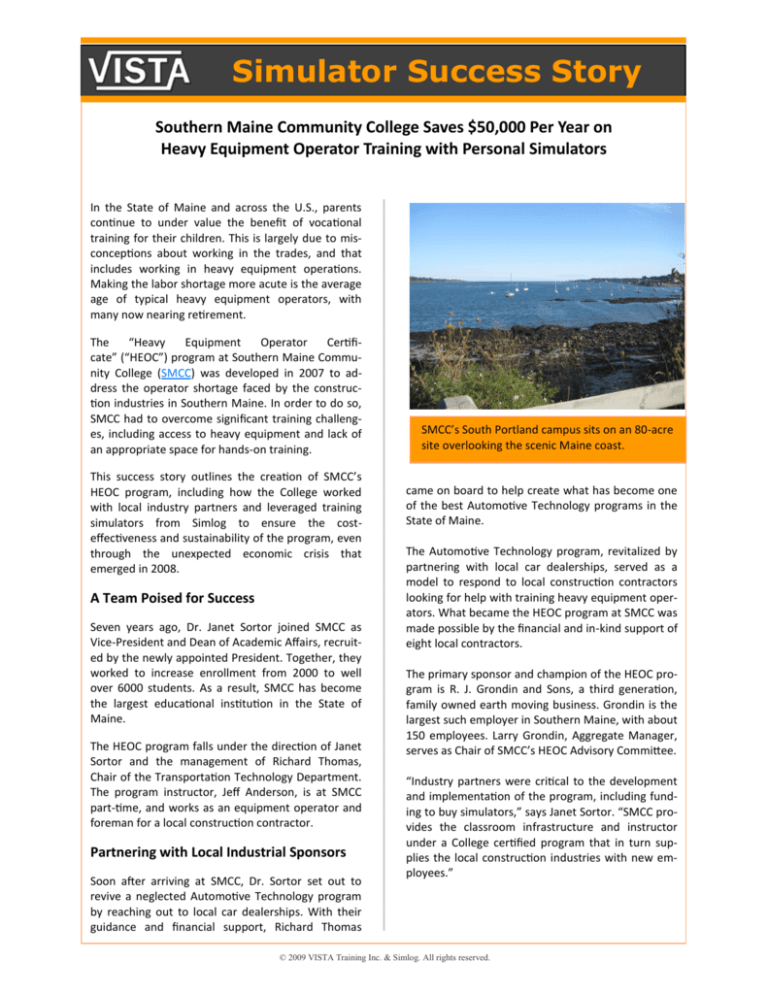
Simulator Success Story
Southern Maine Community College Saves $50,000 Per Year on
Heavy Equipment Operator Training with Personal Simulators
In the State of Maine and across the U.S., parents
continue to under value the benefit of vocational
training for their children. This is largely due to misconceptions about working in the trades, and that
includes working in heavy equipment operations.
Making the labor shortage more acute is the average
age of typical heavy equipment operators, with
many now nearing retirement.
The
“Heavy
Equipment
Operator
Certificate” (“HEOC”) program at Southern Maine Community College (SMCC) was developed in 2007 to address the operator shortage faced by the construction industries in Southern Maine. In order to do so,
SMCC had to overcome significant training challenges, including access to heavy equipment and lack of
an appropriate space for hands-on training.
This success story outlines the creation of SMCC’s
HEOC program, including how the College worked
with local industry partners and leveraged training
simulators from Simlog to ensure the costeffectiveness and sustainability of the program, even
through the unexpected economic crisis that
emerged in 2008.
A Team Poised for Success
Seven years ago, Dr. Janet Sortor joined SMCC as
Vice-President and Dean of Academic Affairs, recruited by the newly appointed President. Together, they
worked to increase enrollment from 2000 to well
over 6000 students. As a result, SMCC has become
the largest educational institution in the State of
Maine.
The HEOC program falls under the direction of Janet
Sortor and the management of Richard Thomas,
Chair of the Transportation Technology Department.
The program instructor, Jeff Anderson, is at SMCC
part-time, and works as an equipment operator and
foreman for a local construction contractor.
Partnering with Local Industrial Sponsors
Soon after arriving at SMCC, Dr. Sortor set out to
revive a neglected Automotive Technology program
by reaching out to local car dealerships. With their
guidance and financial support, Richard Thomas
SMCC’s South Portland campus sits on an 80-acre
site overlooking the scenic Maine coast.
came on board to help create what has become one
of the best Automotive Technology programs in the
State of Maine.
The Automotive Technology program, revitalized by
partnering with local car dealerships, served as a
model to respond to local construction contractors
looking for help with training heavy equipment operators. What became the HEOC program at SMCC was
made possible by the financial and in-kind support of
eight local contractors.
The primary sponsor and champion of the HEOC program is R. J. Grondin and Sons, a third generation,
family owned earth moving business. Grondin is the
largest such employer in Southern Maine, with about
150 employees. Larry Grondin, Aggregate Manager,
serves as Chair of SMCC’s HEOC Advisory Committee.
“Industry partners were critical to the development
and implementation of the program, including funding to buy simulators,” says Janet Sortor. “SMCC provides the classroom infrastructure and instructor
under a College certified program that in turn supplies the local construction industries with new employees.”
© 2009 VISTA Training Inc. & Simlog. All rights reserved.
Program Inception and the Hybrid
Curricular Model
As a leading member of the regional construction
association, Larry Grondin had come to hear about a
new heavy equipment operator training program
established at a high school level vocational training
center in Bangor, Maine with the help of a major
contractor in that area.
That program, with simulator-based training at its
core, served as a different kind of model of what
could be done with (a) sufficient financial and in-kind
support from industrial sponsors, and (b) sufficient
willingness on the part of a local educational institution. This pre-existing program helped establish the
parameters for what became the HEOC program at
SMCC.
As part of their due diligence, the SMCC team also
talked with the staff responsible for the heavy equipment operations program at a community college
based in the northern part of the State of Maine.
The program there relies exclusively on seat-time in
real heavy equipment, with no simulator-based component. SMCC quickly ruled out the creation of a
similar program.
ment, and commercial and residential construction.
“Students enrolling in the program must first complete OSHA and MSHA training, and must have a car
driver's license,” says Richard Thomas, Department
Chair. “Drug testing is also imposed by the contractors in relation to the internship part of the program.”
In addition, all students must pass the SMCC standardized “Accuplacer" entrance exam, as do students
applying to all other programs. Suitably qualified
students then enter the program on a first-come,
first-served basis.
Tuition at SMCC is similar for all programs with an
average (including books) estimated to be USD
$1,500 to USD $2,000. This represents about onethird of the true costs of the technical vocational
training, with the remaining two-thirds coming from
the State of Maine.
To date, few of the incoming students have been
coming from the industrial sponsors. Most of them
are from the State of Maine, but some are from out
of state.
Practically, SMCC lacked both the space on campus
to work with real heavy equipment, and the necessary funds to purchase and maintain such equipment.
“By making simulator time a key part of our program, we can prepare students in the classroom with
practical experience that transfers to machine operation in the field,” explains Janet Sortor. “We are
making training safer and less costly by limiting machine time and wear-and-tear on the contractor’s
equipment, not to mention the $50,000 annual fuel
costs experienced by other programs that do not
utilize simulation.”
For all of these reasons, a hybrid approach to training that relies on simulators in the classroom, and
looks to equipment on loan from industrial sponsors,
proved to be a much simpler and less costly route to
program creation.
Richard Thomas, Department Chair, next to one of the seven
excavator cabins donated by an industrial sponsor to house
the Personal Simulators in SMCC’s simulator lab.
HEOC Program Overview
HEOC Program Curriculum
The HEOC program is a one year certificate program
designed to produce operators trained on earth
moving equipment such as dozers, backhoes, excavators, and graders. Graduates will be prepared to
work in county, state, or interstate highway construction, agricultural construction, airport develop-
SMCC’s Hybrid Curricular Model incorporates traditional classroom based instruction, competency
based simulated operator training, gravel pit based
hands-on skill development with equipment, and a
hands-on internship in the field.
© 2009 VISTA Training Inc. & Simlog All rights reserved.
Currently, the HEOC program is comprised of the
following courses:
Electricity and Electronics
English Composition
Introduction to Construction Safety
Maintenance and Service
Backhoe and Excavator Simulation Lab
Principles of Site Finishing and Grades
College Algebra and Trigonometry
Introduction to Welding
Heavy Equipment Operations Internship
Backhoe and Excavator Simulation Lab
SMCC's simulator lab is composed of 7 Hydraulic
Excavator Personal Simulators purchased from Simlog Inc., the developer of the simulation software.
Each simulator station is equipped as
follows:
One desktop PC
Two original equipment (OEM) joysticks
mounted to an office chair
A real excavator cab donated by a local heavy
equipment dealer
An LCD display mounted on the inside of the cab
The 7 desktop PCs are networked together and
linked to a common database, called Simlog’s Simulation Manager, which controls all user login accounts and automatically keeps track of students’
simulation results.
Operator Training in Five Steps
Including the time students spend in the simulator lab, the actual backhoe and excavator operator training part of the program is carried out in 5
steps:
Step 1: Operator Safety — The 1st semester
begins in early September with an 18-hour
course in which students acquire the knowledge
to safely work on a heavy equipment construction site. For example, how to perform a prestart safety inspection, as well as how to properly start up and shut down the equipment.
Step 2: Equipment Familiarization — The 1st
semester continues with 60 hours of classroom
time combined with time in a local gravel pit
provided by the primary industrial sponsor, R.J.
Grondin, in the nearby town of Buxton. Students
become familiar with various types of equipment, but at this stage they do not operate the
equipment. Students work just day shifts in the
gravel pit.
This step corresponds to the National Center for
Construction Education and Research (NCCER)
"Level 1" training.
Step 3: Training in the Simulator Lab — The 1st
semester ends with 90 hours in the simulator
lab. Students train on the simulators by working
through 10 of the 12 built-in Simulation Modules, with each Simulation Module progressively
increasing in level of difficulty over the last. This
is core to the simulation software’s Instructional
Design.
Benchmarks were established for all 10 Simulation Modules by the instructor, along with a
grading system (A+, A, A-, etc.) based on the
relative numbers from the Key Performance
Indicators associated with the quality of the
students’ work.
“Rather than incorporating benchmarks for execution time or productivity, which is also measured by the simulators, we use a single test for
grading productivity,” explains Richard Thomas.
”During a single class period of 2 hours and 45
minutes, students work through the 10 Simulation Modules and anything less than C is a failing
grade.”
A closer look at the Hydraulic Excavator Personal Simulator
with Original Equipment (OEM) joysticks mounted to an office
chair inside a real excavator cab.
After so many hours in the simulator lab, most
students obtain a grade of A.
© 2009 VISTA Training Inc. & Simlog. All rights reserved.
Step 4: Training at the Controls of Real Equipment — Once students are sufficiently prepared
in the simulator lab, they return to the same
gravel pit as Step 2 for 90 hours of seat-time at
the controls of 2 or 3 pieces of equipment, typically wheel loader, bulldozer and excavator, for
no more than 30 hours in each one. As before,
students work just day shifts, and this brings the
2nd semester to a close at the end of May.
This step corresponds to the NCCER "Level 2"
training.
Step 5: Internship — Students complete the
program by spending the month of June as interns with the industrial sponsors, to be introduced to work conditions in a real world context.
The number of possible internships serves to
limit enrolment in the program. In other words,
in order to take on more students, SMCC would
need to add a corresponding number of new
internships.
During the internship, each student submits a
weekly report to SMCC about their activities to
help SMCC supervise the work assigned to the
students. After 2 weeks, the industrial sponsors
submit preliminary student evaluations to
SMCC. The final evaluations are submitted 2
weeks after the internship ends, and counts for
75% of the student’s grade.
Backhoe and Excavator Operator Training
Step
Location
Duration
1. Operator Safety
Classroom
18 Hours
2. Equipment
Familiarization
Classroom and
Gravel Pit
60 Hours
3. Simulator Lab
Classroom
90 Hours
4. Hands-On
Operation
Gravel Pit
90 Hours
5. Internship
Industrial Sponsor
1 Month
operator training to help promote the HEOC program, and vocational training in general, especially
at the local high schools.
HEOC Program Success to Date
SMCC’s HEOC program began in September 2007,
with the 1st group of 7 students graduating in June
2008. The 2nd group of students started in September 2008 and 6 graduated in June 2009. The 3rd
group started in September 2009, with 7 students.
“With an initial investment of around $40,000 for
the simulation software and controls, we can give 7
students a total of 630 hours of simulator time per
year, accounting for half of their practical training,"
says Janet Sortor. "With HEOC now in its 3rd year,
the simulators have already paid for themselves almost twice over on just fuel savings alone, and not
counting less wear-and-tear on our sponsor's equipment.”
Most graduates have gone on to work in the construction industry, with some joining R.J. Grondin,
the program’s primary industrial sponsor, as laborers
pre-trained to be equipment operators.
Looking to the Future
In 2010, the newly-closed Brunswick Naval Air Station near Portland will become a satellite campus of
SMCC. As a result, a certain number of programs will
be moved from the existing SMCC campus in South
Portland. It is expected that Heavy Equipment Operations will be included in the move, along with a
complementary new program in heavy equipment
maintenance.
“With new facilities on the horizon, it will become
possible to create a two year Associate program by
increasing the scope of the current program,” says
Richard Thomas. “New subjects might include simple
soil analysis, wetlands development, and environmental hazards.”
It is also hoped that by then, new simulation software from Simlog to train bulldozer and motor grader operators will be available to establish a
"Bulldozer and Grader Simulation Lab.”
VISTA Training Inc. is a reseller of the Simlog line
of personal simulators. To learn more, please
contact:
HEOC Program Promotion
Aware of the misconceptions among young people
about working in the trades, and the challenges this
poses to recruiting students, SMCC also uses the
same heavy equipment simulators purchased for
Angela Remington at 800-942-2886 ext. 203 or
via e-mail at aremington@vista-training.com.
© 2009 VISTA Training Inc. & Simlog All rights reserved.

